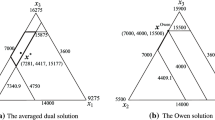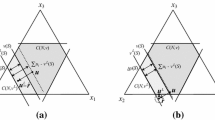Abstract
We introduce a generalized linear production model whose attractive feature being that the resources held by any subset of producersS is not restricted to be the vector sum of the resources held by the members ofS. We provide sufficient conditions for the non-emptiness of the core of the associated generalized linear production game, and show that if the core of the game is not empty then a solution in it can be produced from a dual optimal solution to the associated linear programming problem. Our generalized linear production model is a proper generalization of the linear production model introduced by Owen, and it can be used to analyze cooperative games which cannot be studied in the ordinary linear production model framework. We use the generalized model to show that the cooperative game induced by a network optimization problem in which players are the nodes of the network has a non-empty core. We further employ our model to prove the non-emptiness of the core of two other classes of cooperative games, which were not previously studied in the literature, and we also use our generalized model to provide an alternative proof for the non-emptiness of the core of the class of minimum cost spanning tree games. Thus, it appears that the generalized linear production model is a unifying model which can be used to explain the non-emptiness of the core of cooperative games generated by various, seemingly different, optimization models.
Similar content being viewed by others
References
L.J. Billera and R.E. Bixby, “Market representation ofn-person games“,Bulletin of the American Mathematical Society 80 (1974) 522–526.
C. Bird, “On cost allocation for a spanning tree: A game theoretic approach“,Networks 6 (1976) 335–350.
O.N. Bondareva, “Some applications of linear programming methods to the theory of cooperative games“, (in Russian)Problemy Kibernetiki 10 (1963) 119–139.
A. Charnes and K.O. Kortanek, “On balanced sets, cores and linear programming“,Cahiers du Centre d'Etudes de Recherches Opérationnelles 9 (1967) 32–43.
P. Dubey and L.S. Shapley, “Totally balanced games arising from controlled programming problems“,Mathematical Programming 29 (1984) 245–267.
J. Edmonds, “Maximum matching and a polyhedron with 0,1 vertices“,National Bureau of Standards Journal of Research 69B (1965) 125–130.
J. Edmonds, “Optimum branchings“,National Bureau of Standards Journal of Research 71B (1967) 233–240.
D. Gale and L.S. Shapley, “College admissions and the stability of marriage“,American Mathematical Monthly 69 (1962) 9–14.
R.E. Gomory and T.C. Hu, “An application of generalized linear programming to network flows“,Journal of the Society for Industrial and Applied Mathematics 10 (1962) 260–283.
D. Granot, “A note on the room-mates problem and a related revenue allocation problem“,Management Science 30 (1984) 633–643.
D. Granot and G. Huberman, “Minimum cost spanning tree games“,Mathematical Programming 21 (1981) 1–18.
D. Granot and G. Huberman, “On the core and nucleolus of minimum cost spanning tree games“,Mathematical Programming 29 (1984) 323–347.
D. Granot and F. Granot, “On some network flow games”, Working Paper No. 1056, Faculty of Commerce and Business Administration, University of British Columbia, Vancouver (1984).
E. Kalai and E. Zemel, “Generalized network problems yielding totally balanced games“,Operations Research 30 (1982) 998–1008.
G. Owen, “On the core of linear production games“,Mathematical Programming 9 (1975) 358–370.
L.S. Shaplley, “On balanced sets and cores“,Naval Research Logistics Quarterly 4 (1967) 453–460.
L.S. Shapley and M. Shubik, “The assignment game I: The core“,International Journal of Game Theory 1 (1972) 111–130.
M.J. Todd, Private Communication, June 1985.
Author information
Authors and Affiliations
Additional information
Dedicated to George B. Dantzig.
This research was partially done while the author was visiting the Graduate School of Business Administration at Tel-Aviv University. The research was partially supported by Natural Sciences and Engineering Research Council Canada Grant A4181 and by SSHRC leave fellowship 451-83-0030.
Rights and permissions
About this article
Cite this article
Granot, D. A generalized linear production model: A unifying model. Mathematical Programming 34, 212–222 (1986). https://doi.org/10.1007/BF01580585
Received:
Revised:
Issue Date:
DOI: https://doi.org/10.1007/BF01580585




